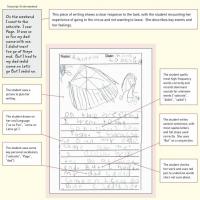The writing standard
Key characteristics of students' writing at this level
Students will plan for writing, using talk or pictures. They will independently write simple texts, drawing on the knowledge, skills, and attitudes that will help them achieve their purpose. The knowledge, skills, and attitudes expected at this level, including those needed for spelling and punctuation, are described in the Literacy Learning Progressions.
The texts that students write will include, when appropriate:
- an idea, response, opinion, or question
- several sentences (including some compound sentences with simple conjunctions such as 'and')
- some key personal vocabulary and high-frequency words
- attempts at transferring words encountered in the writer's oral language or reading to their writing.
Illustrating the writing standard
On the weekend
The task exemplifies the writing demands of the English curriculum within level 1.
The students have been writing independently about their favourite holiday activity. They have been asked to plan, write, and then check their work.
This is the student’s first draft. Features of the writing that demonstrate the standard are described below.
This example illustrates the sorts of writing that teachers can expect of students who are meeting the standard. To meet the standard, students draw on the knowledge, skills, and attitudes for writing described in the Literacy Learning Progressions for students at this level.
I wonder why we have night and day?
The task exemplifies the writing demands of the English and science curriculum learning areas within level 1.
The students have been asked to write an explanation to answer the question 'I wonder why we have night and day?' The teacher has supported the students in this task by having them practise giving oral explanations on a familiar topic and by building their understanding of the topic through a variety of practical activities. The teacher has also provided appropriate reference materials and has explicitly taught relevant vocabulary.
This example illustrates the sorts of writing that teachers can expect of students who are meeting the standard. To meet the standard, students draw on the knowledge, skills, and attitudes for writing described in the Literacy Learning Progressions for students at this level.
Writing at home
Make writing fun
- Help your child write an alphabet letter, then go letter hunting in your house or in a book to find that letter
- Let your child see you writing – you can use your first language
- Encourage them to write shopping lists or make birthday cards
- Water and a paintbrush on a dry path and a stick on sand are fun ways to write letters and words.
Here's a tip - Don’t worry if your child’s letters or words are sometimes backwards or misspelt at this age. The important thing is that they have fun writing at home and are making an effort.
Give them reasons to write
- Write to each other. Write notes to your child and leave them in interesting places, like their lunch box. Ask them to write a reply
- Help them email, text or write to family, whānau or friends
- Work with them to put labels on special things – like the door to their room or their toy box.
Here a tip - display their work. Put it on the fridge. Be proud of it. Share it with others.
Talk about their writing
- Talk about the letters in your child’s name and where the name comes from.
- Help them create a scrapbook with pictures. Encourage them to write stories under the pictures and talk to you about them.
- Ask them to write about pictures they draw - on paper or on the computer. Or get them to tell you the story and you write it under the picture.
Here's a tip - talk about what your child writes. Be interested. If you don’t understand what your child’s picture or story is about, ask them to tell you about it.
Encourage writing
- Have felt pens, pencils, crayons and paper available
- Put magnetic letters on the fridge – ask what words they can make with the letters.


No comments:
Post a Comment